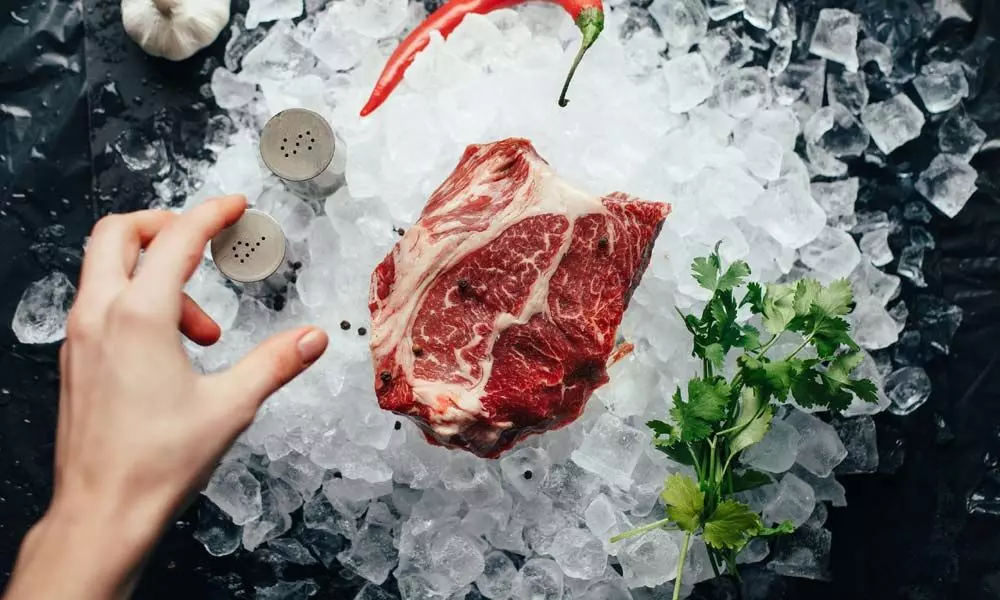Live
- Rachakonda police issues prohibitory orders in view of TGPSC tests
- SBI rescues sr citizen from `46L cyber fraud
- 12-yr-old dies of electrocution
- Installation of smart meters opposed
- State Cabinet expansion in focus as CM leaves for Delhi
- Need to reintroduce country’s forgotten pride: Bhagwat
- Pant shatters Iyer's IPL auction record, sold to Super Giants for Rs 27 cr
- Yuva Sangeetha Sammelanam held
- Dharani proves a bane for 25K families across State
- Reckless, Dangerous Arms Race
Just In

Jhatka or halal? Experts say both are painless methods
After ban on hijab in educational institutions and Muslim vendors in the vicinity of Hindu temples, ‘halal’ meat has become an issue that threatens to widen the gulf between the people of two religions.
Bengaluru: After ban on hijab in educational institutions and Muslim vendors in the vicinity of Hindu temples, 'halal' meat has become an issue that threatens to widen the gulf between the people of two religions. The issue is seen as a political strategy to consolidate Hindu vote bank by the ruling Bharatiya Janata Party in the State to win the Assembly election in 2023.
Undoubtedly, a tense situation prevails between the two communities. Five Bajrang Dal members were recently arrested for allegedly attacking a Muslim meat traderfor selling halal-cut meat in Shivamogga district.
The call to Hindus to buy 'jhatka' meat is being intensified and is turning into a big political controversy. Some experts offer their opinion on this.
"The animal is usually slaughtered using a sharp object in a quick way so that the pain is minimised. The throat, wind pipe and the blood vessels in the neck are cut without any damage to the spinal cord in halal," Dr Sarmad Khan, University of Punjab, told The Hans India. Blood should be drained out of the animal completely before the head is removed. "Since blood is a good medium for bacteria, germs and other toxins, it has to be eliminated to prevent any infectious diseases. The animal does not feel any pain in this method as the process disconnects the flow of blood to the body. However, the struggling and withering of the animal is due to the contraction and relaxation of muscles deficient in blood and the blood flowing out of the body, not because of the pain," he adds.
"While in jhatka method, the animal's head is severed in one single blow where the head is separated from the body and as they aim at the whole neck, the spinal cord is severed along with the other parts and hence, there won't be any pain caused. Although, in halal, when there is a change in the colour of the blood while it oozes out of the body, one can understand if it is fit for consumption or not. It maybe any form of slaughtering, jhatka or halal, both the meats are fit for consumption as they are age-old traditions followed by the respective religions," says Yeshwanth B.R, a lecturer in Biology.
"Halal has very less to do with religion. While the animal is being slaughtered, the blood is drawn out completely so that it becomes fit for consumption as it avoids any infections. There was an experiment carried out by William Schulze at the University of Veterinary Medicine Hanover. There were two devices used in this experiment, EEG to record the brain activity and the ECG to record the heart activity of an animal. During the first three seconds, the EEG's graph did not indicate any change which depicts that the animal did not feel any pain during the slaughtering and in the next few seconds, the ECG recorded a condition of deep sleep and unconsciousness which is due to a large quantity of blood flowing out of the animal's body," says Mohammed Imad.

© 2024 Hyderabad Media House Limited/The Hans India. All rights reserved. Powered by hocalwire.com







